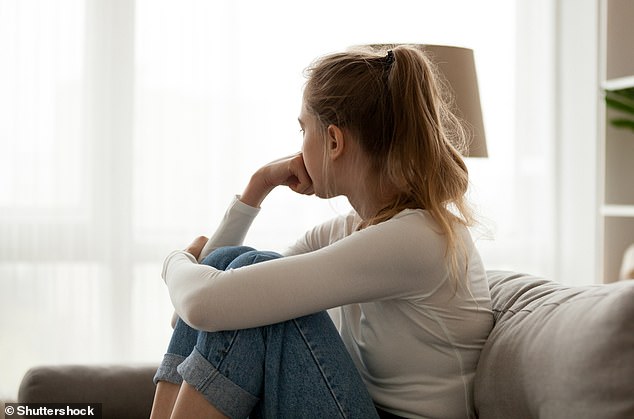Teenagers who dislike their physical appearance are up to three times more likely to be depressed as adults, an alarming new study finds.
UK researchers measured body dissatisfaction at 14 and depression at 18 of 3,753 young adults born in the west of England in 1991 and 1992.
Increased depression risk varied based on gender and severity but teenage boys are at 285 per cent heightened risk of severe depression, the study found.
While in girls an increase in body dissatisfaction led to a 84 per cent increase in the risk of a severe depressive episode at 18.
The study authors say internet, technology and social media are having an effect on ‘body dissatisfaction’ felt by millennials – those born between 1981 and 1997.
e Body dissatisfaction is prevalent in mid-adolescence and may be associated with the onset of depression (stock photo)
Dislike of one’s physical appearance, formally known as body dissatisfaction, affects up to 61 per cent of teens worldwide, according to a previous study.
Body dissatisfaction has been identified as a risk factor for eating disorders, unhealthy behaviours, and poor mental health.
While it’s been said that females are more sensitive to the body image ideals, the spread of social media may be to blame for male adolescents experiencing body dissatisfaction too, which may translate into later depressive episodes.
‘This is the first prospective study to demonstrate that body dissatisfaction in adolescence predicts the occurrence of later depressive episodes in a cohort born in the early 1990s,’ say the researchers, from the University of West of England in Bristol and Erasmus University Rotterdam, the Netherlands.
‘These findings highlight the importance of recognising body dissatisfaction as a public health concern.’
Most published research on body dissatisfaction and depression has been carried out in the US, while ‘relatively little attention has been given in European contexts’, especially in the UK.
Also, few studies have explored the issue among young men and millennials to account for the influence of the internet, technology and social media.
For their study, researchers used 3,753 participants – 2,078 females and 1.675 males – all enrolled in the Avon Longitudinal Study of Parents and Children (ALSPAC).
ALSPAC is a large birth cohort consisting on children born to women in the southwest of England with a due date between April 1, 1991 and December 21, 1992.

Boys were found to be more likely to experience severe depression than girls, according to the University of West of England study
When they were 14, teens were asked to rate satisfaction with their physical appearance by scoring their weight, figure, body build and specific areas, including breasts, stomach, waist, thighs, buttocks, hips, legs, face and hair.
These features were rated based on the five-point Likert scale, where zero equals ‘extremely dissatisfied’ and five equals ‘extremely satisfied’.
Both the boys and the girls were mildly satisfied with their body overall at the age of 14, although girls were more dissatisfied than boys.
Girls tended to dislike their thighs, stomach and weight, but liked their hair and hips, while boys tended to be dissatisfied with body build, stomach, and hips, but weren’t bothered about their hair, weight or legs.
At 14 years, 32 per cent of the girls and 14 per cent of the boys were dissatisfied with their weight, and 27 per cent of girls and 14 per cent of boys were dissatisfied with their figure.
Around four years later, depression was assessed clinically by a nurse at an average age of 17.80 years old using the Computerised Interview Schedule – Revised (CIS-R).
CIS-R asks questions about a range of symptoms and can be used to assign diagnoses of depression and anxiety disorders.
CIS-R elicits responses to symptoms of depression experienced in the past week and provides a diagnosis of depression according to the World Health Organisation’s ICD-10 criteria.
ICD-10 criteria for mild, moderate and severe depression were used to categorise depression severity
Overall, girls were more likely to experience episodes of depression than boys at 18 years, the research team found.
In all, 10 per cent of the girls reported at least one mild depressive episode compared 5 per cent of the boys.
6.7 per cent of the girls and 2.6 per cent of boys reported at least one moderate depressive episode, while severe depressive episodes affected 1.5 per cent of the girls and 0.7 per cent of the boys.
Body dissatisfaction at the age of 14 years predicted the prevalence of of all degrees of severity – mild, moderate and severe depressive episodes – among females, the team found, while controlling for initial levels of depression at 14.
Body dissatisfaction at the age of 14 years predicted only mild and severe depressive episodes among males at 18 years of age, while also controlling for initial levels of depression.

Participants were asked to rate their body satisfaction at the age of 14 and depressive symptoms at the age of 18. Dislike of one’s physical appearance, formally known as body dissatisfaction, affects up to 61 per cent of teens worldwide
Among the girls, each increase in the body dissatisfaction scale at the age of 14 was associated with a heightened risk of experiencing at least one mild (63 per cent), moderate (67 per cent) and/or severe (84 per cent) depressive episode at 18.
The strength of this association increased with the severity of the depressive episode.
The impact of body dissatisfaction on mild depressive episodes was comparable between boys and girls, but its impact on severe depressive episodes was stronger among the boys.
Each increase in the body dissatisfaction scale at the age of 14 among the boys was associated with a heightened risk of experiencing at least one mild (50 per cent) and/or severe (285 per cent) depressive episode at the age of 18.
‘Outcomes might differ from previous cohorts also due to the important role that the internet, technology and social media have on lifestyles of more recent generations,’ the team conclude.
Researchers acknowledge a lack of ethnic and socioeconomic diversity in the ALSPAC data, which is based on babies born in the west of England in the early 1990s.
Other limitations include an absence of any information on sexual orientation and the fact that the measure of body dissatisfaction assessed in the questionnaires was skewed towards female appearance ideals.
The study has been published in the Journal of Epidemiology & Community Health.

